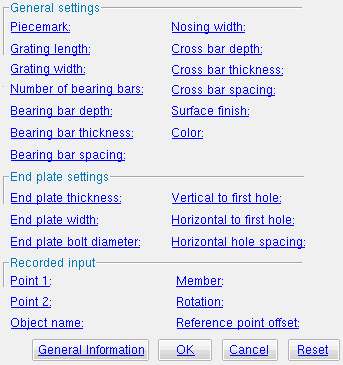The Grating Tread Material window
- Establishing the material's work line
- Making entries to this window
- "Add Grating Tread" or "Misc Grating Tread" (results)
Also see :
| Quick Notes |
- Parametric Point Maps
- Objects, Attributes, Methods and Functions
- Grating Material (similar window - Modeling )
Warning : If your startup code specifies imperial Units("...") , make entries to distance fields on this window in decimal inches, not fractions. Also, do not use hyphens (-). If you enter a fraction using integers, Python truncates the results of the division operation to an integer (examples: 1/8 = 0 ; 5/4 = 1 ). If you enter fractions with decimal points, Python calculates the precise decimal value (examples: 1.0/8.0 = .125 ; 5.0/4.0 = 1.25 ). If you enter a hyphen, Python interprets the hyphen as a minus sign (examples: 1-2 = -1 ; 3-2 = 1 ). See numbers (floating point numbers and integers).
Tips :
To enter a dimension string and convert it to a floating point distance that is properly factored based on the startup code Units("...") , you can use the dim("...") function. See the warning above for an explanation of why the dim() function is needed.
------ General settings ------
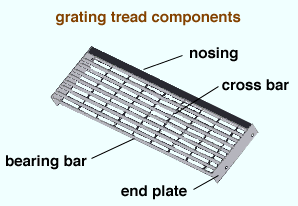
Piecemark: You can add a line of code such as obj.MinorMark = "xxx" or obj.Piecemark = "xxx" in a text editor.
For submaterials ( obj . MinorMark or obj.mark ):
If you Run a script that does not include obj.MinorMark , SDS2 piecemarking looks for materials in the current Job that are physically identical to this material and assigns to this material the same submaterial mark assigned to those materials. If no matching materials are found, piecemarking assigns this material a submaterial mark using the appropriate piecemark prefix listed in Home > Project Settings > Fabricator > Member and Material Piecemarking > the " Prefixes " tab.
If you Run a script with obj.MinorMark = "xxx" , SDS2 piecemarking applies that submaterial mark ( xxx ) to the parametrically added material if no other material has yet been assigned that mark. It also applies that mark ( xxx ) if other materials that have that mark ( xxx ) are exactly like the parametrically added material. If the model contains materials with a different submaterial mark ( yyy ) that are exactly like the parametrically added material, the submaterial mark of those materials ( yyy ) is re-named to that of the parametrically added material ( xxx ). If the model contains materials with the same submaterial mark that the script designates to be assigned to the parametrically added material ( xxx ) and those materials are different than the parametrically added material, the submaterial mark in the script is not applied -- instead you get a warning and the parametrically added material is assigned a different submaterial mark using the appropriate piecemark prefix listed in Home > Project Settings > Fabricator > Member and Material Piecemarking > the " Prefixes " tab.
For miscellaneous members ( obj . Piecemark or obj.piecemark ):
If you Run a script that does not include an obj.Piecemark , a system piecemark is assigned to the parametrically added member.
If you Run a script with an obj.Piecemark , be careful. You are responsible for ensuring that members that have been assigned the same user piecemark are physically the same. SDS2 piecemarking does not do this for you.
Tip 1: A Python script can read the submaterial mark of a material as shown in the following example.
# Prints the piecemark of the material the user selects.
from mtrl_list import MtrlLocate
mtrl1 = MtrlLocate("Select material", "Single")
print("The material piecemark is: ", mtrl1.MinorMark)Tip 2: A script can also read member piecemarks (user or system).
# Prints the piecemark of the member that the user selects.
from member import MemberLocate
from param import ClearSelection
mem1 = MemberLocate("Select a member")
print("The piecemark is: ", mem1.Piecemark)
ClearSelection()Grating length ( obj . Length or obj.length ): The length of the grating tread along its longitudinal axis ( X material axis ). Length is a floating point number in mm or inches, depending on the startup code Units(' ... ') .
Example 1: Entering a specific distance results in the length of the material being that set value when this script is Run.
Example 2: Entering the expression gt1.Point1.Distance(gt1.Point2) calculates the grating length based on the distance between the two work points (" Point 1 " and " Point 2 "). The resulting line of parametric code reads: gt1.Length = gt1.Point1.Distance(gt1.Point2).
Grating width ( obj . Width or obj.width ): The width of the grating tread along its Y material axis . Width is a floating point number in mm or inches, depending on the startup code Units(' ... ') .
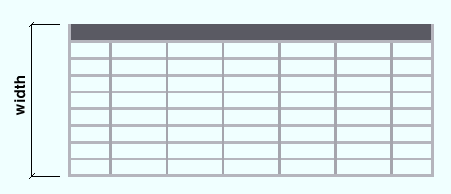
Example: Entering the expression gt1.NosingWidth + gt1.BearingBarSpacing * (gt1.NumberOfStringersInGrate-1) + gt1.BearingBarThickness calculates the grating width as follows: nosing width + [( bearing bar spacing )( number of bearing bars - 1)] + bearing bar thickness . The resulting line of parametric code reads: gt1.Width = gt1.NosingWidth + gt1.BearingBarSpacing * (gt1.NumberOfStringersInGrate-1) + gt1.BearingBarThickness.
Number of bearing bars ( obj . NumberOfStringersInGrate or obj.num_bbar ): The total number ( integer > 0) of bars that are parallel with the grating tread's X material axis . Each of these bars is slightly shorter than the " Grating length " is long.
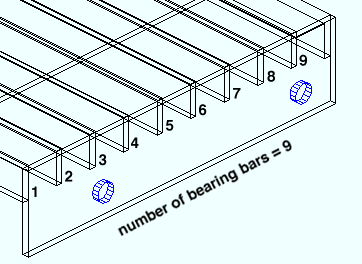
Bearing bar depth ( obj . BearingBarWidth or obj.bbar_depth ): The distance between the top and bottom edges of any one bearing bar. All bearing bars are this same depth. Depth is measured perpendicular to the workline of the grating tread. A distance is a floating point number in mm or inches, depending on the startup code Units(' ... ') .
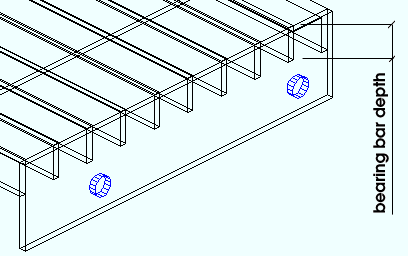
Bearing bar thickness ( obj . BearingBarThickness or obj.bbar_thick ): The thickness of any one bearing bar. All bearing bars are this same thickness. Thickness is a floating point number in mm or inches, depending on the startup code Units(' ... ') .
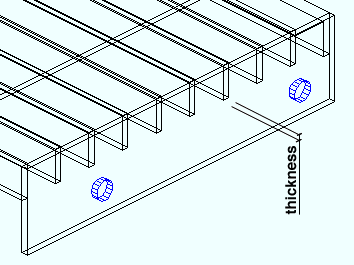
Bearing bar spacing ( obj . BearingBarSpacing or obj.bbar_spa ): The distance between any one bearing bar and the next bearing bar plus the thickness of the one bearing bar. A distance is a floating point number in mm or inches, depending on the startup code Units(' ... ') .
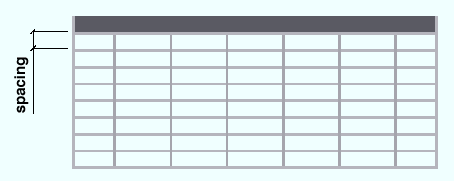
Nosing width ( obj . NosingWidth or obj.nosing_width ): The width of the nosing plate. This distance is perpendicular to the work line and measured from the workline edge of the grating tread to the nearest edge of the nearest bearing bar. Width is a floating point number in mm or inches, depending on the startup code Units(' ... ') .
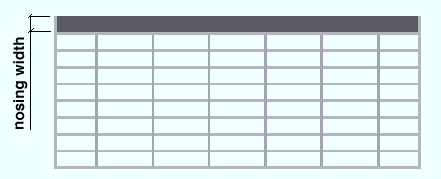
Cross bar depth ( obj . CrossBarWidth or obj.cbar_depth ): A distance ( floating point number ) in mm or inches, depending on the startup code Units(' ... ') . This distance is measured perpendicular to the work line of the grating tread between the top and bottom edges of any one cross bar. In other words, this is the Z material axis dimension of the cross bar. All cross bars are the depth you specify here.
Example: For grating tread laid out in a plan view, this distance is the difference between the elevation of the top of the cross bar and the bottom of that same cross bar.
Cross bar thickness ( obj . CrossBarThickness or obj.cbar_thick ): The thickness of any one cross bar. All cross bars are this same thickness. The returned value is a floating point number in mm or inches, depending on the startup code Units(' ... ') .
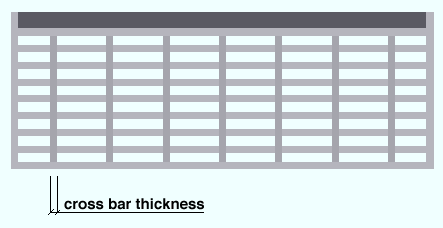
Cross bar spacing ( obj . CrossBarSpacing or obj.cbar_spa ): The distance between any one cross bar cross bar and the next cross bar plus the thickness of the one cross bar. A distance is a floating point number in mm or inches, depending on the startup code Units(' ... ') .
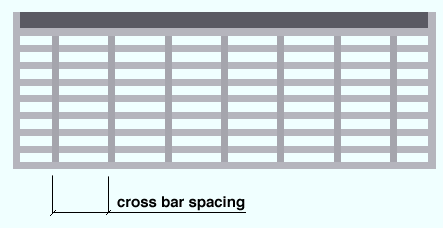
Note: The number of cross bars in the grating tread is determined by the length of the grating tread and the cross bar spacing. This means, for example, that if you were to increase the cross bar spacing, the number of cross bars might decrease since the " Grating length " would remain the same.
Surface finish ( obj . SurfaceFinish or obj.finish ): "None" or "Sand Blasted" or "Red Oxide" or "Yellow Zinc" or "Gray Oxide" or "Blued Steel" or "Galvanized" can be selected on the list box ( ![]() ) for this field. The choice you make here assigns the selected string as the SurfaceFinish attribute for this " Object name " in the parametric code.
) for this field. The choice you make here assigns the selected string as the SurfaceFinish attribute for this " Object name " in the parametric code.
|
||||||
| The colors of materials on Drawing Editor erection views in ' Solid ' are based on their surface finish. |
Example: Selecting Yellow Zinc results in a line of parametric code that reads: obj.SurfaceFinish = "Yellow Zinc" (where obj is the " Object name ").
Also note: When you export a KISS file using Model as the " Data source ," surface finish data on materials are compiled into the P lines in the KISS download. Surface finish data can also be output to a fabtrol_assembly_parts_list.XSR file.
Color ( obj . MaterialColor3d or obj.color ): A "named_color" or a custom color . The choice you make here assigns three values (RGB values) from 0 to 255, which define the color of the grating tread when it is displayed in one of the three solid forms .
The "named_colors" are set up on the Predefined Colors window. The color swatch next to the list box (
) displays the color that is selected. Example: Selecting Medium_beam results in a line of parametric code that reads: obj.MaterialColor3d = "Medium_beam" (where obj is the " Object name ").
Select Custom Color (last option on the menu) to launch your operating system's color picker and define any color you like. Example: Selecting a custom color results in a line of parametric code that reads: obj.MaterialColor3d = (r, g, b) where r or g or b is an integer value from 0 to 255 and obj is the " Object name ".
------ End plate settings ------
End plate thickness ( obj . EndPlatesThickness or obj.end_thick ): The thickness of the grating tread's end plate. Thickness is a floating point number in mm or inches, depending on the startup code Units(' ... ') .
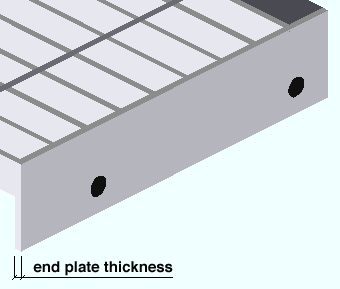
End plate width ( obj . EndPlatesDepth or obj.end_width ): A distance ( floating point number ) in mm or inches, depending on the startup code Units(' ... ') . This distance is measured from the workline that was established when work points were laid out for this grating tread to the bottom edge of the end plate.
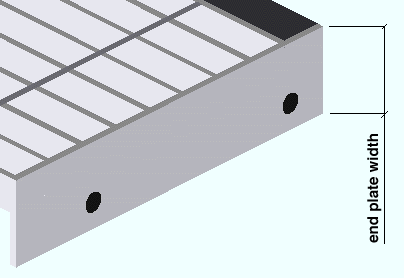
End plate width is measured perpendicular to the work line of the grating tread; for grating tread laid out in a plan view, the top edge of the end plate is at the same elevation as the workline (and of the top surface of the grating tread). The length of the grating tread's end plate is determined by the " Grating width ."
End plate bolt diameter ( obj . HolesBoltDiameter or obj.bolt_dia ): The diameter of bolt that you wish to use in the end plates of this grating tread. You can type in a diameter or select a bolt diameter from the list box ( ![]() ). Diameters listed on the menu come from Home > Project Settings > Job > Bolt Settings > the " Available bolt diameters " list.
). Diameters listed on the menu come from Home > Project Settings > Job > Bolt Settings > the " Available bolt diameters " list.
Grating end plate holes are standard round holes. The diameter of these holes is calculated from the " End plate bolt diameter " per Table J3.3 or Table J3.3M ( AISC Thirteenth Edition , p. 16.1-105).
Vertical to first hole ( obj . HolesVerticalDistance or obj.vert_to_first ): Assuming that the grating tread was laid out in a plan view without rotation, this is the vertical distance (a floating point number in the startup code " Units ") from the top edge of the end plate to the center of the first hole. This distance is not vertical if the top of the grating tread is not in the plane of a plan view. The first hole is the hole that is nearest to the workline of the grating tread.
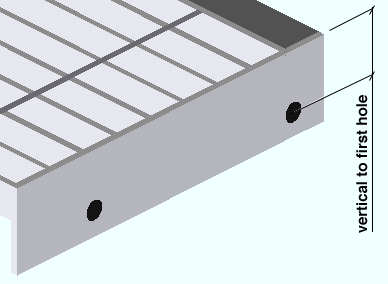
Horizontal to first hole ( obj . HolesHorizontalDistance or obj.horz_to_first ): Assuming that the grating tread was laid out in a plan view without rotation, this is the horizontal distance (a floating point number in the startup code " Units ") from the nosing edge of the end plate to the first hole. This distance is not horizontal if the top of the grating tread is not in the plane of a plan view. Grating tread nosing is along the workline that was established when work points were laid out for the grating tread.
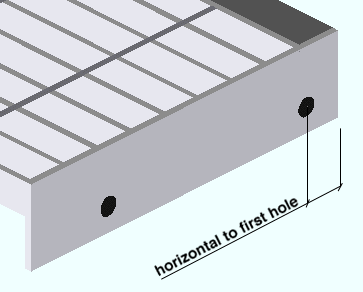
Horizontal hole spacing ( obj . HolesHorizontalSpacing or obj.hole_spa ): A distance ( floating point number ) in mm or inches, depending on the startup code Units(' ... ') . This distance sets the number of holes on the end plate. If grating width - (2)( horizontal to first hole ) > (2)(horizontal hole spacing), then program adds three holes (or more holes if there is enough space). If grating width - (2)( horizontal to first hole ) > (3)(horizontal hole spacing), four (or more) holes are added.
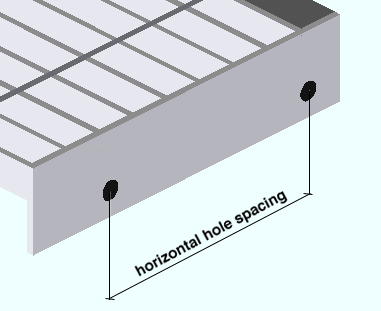
![]()
![]()
![]()
![]()
" General Information " opens the Parametric General Information window so that you can assign a " Description " or " Material usage description " or " Material routing " to this material. Making entries to fields on the General Information window adds extra lines to the parametric code.
"OK" (or the Enter key) closes this window and saves your changes to RAM.
"Cancel" (or the Esc key) closes this window without saving any changes.
"Reset" undoes all changes made to this window since you first opened it. The window remains open.
